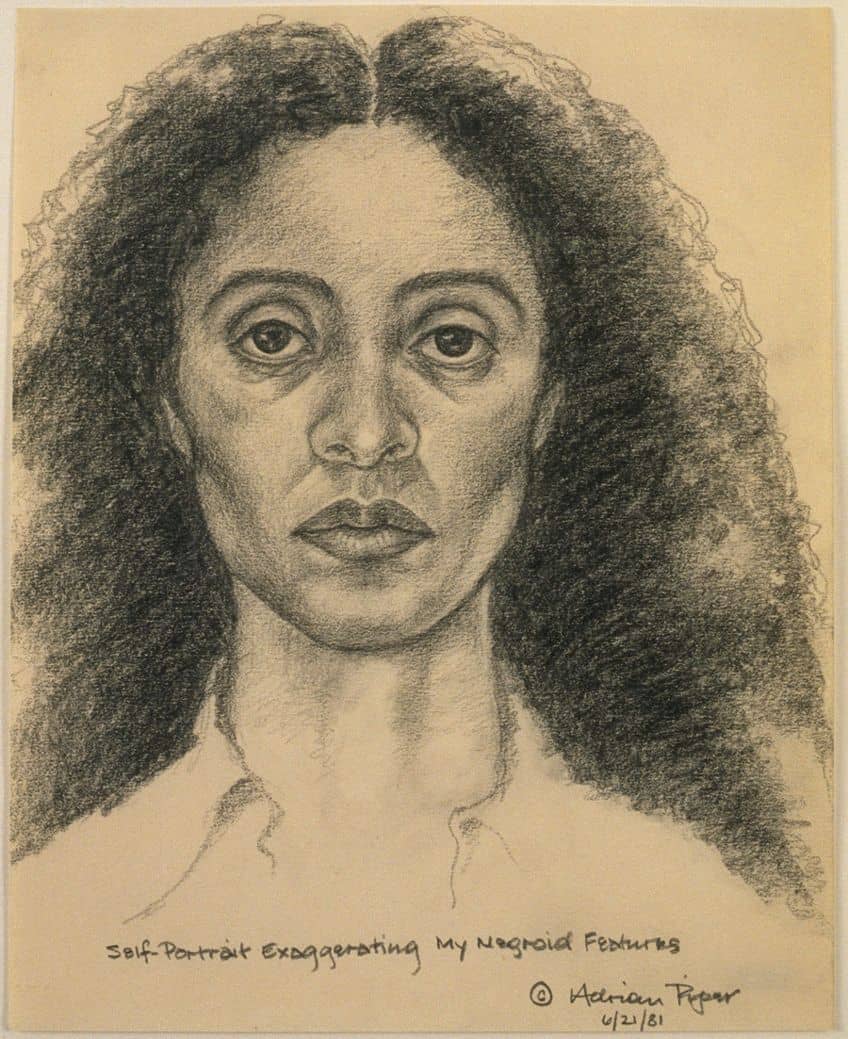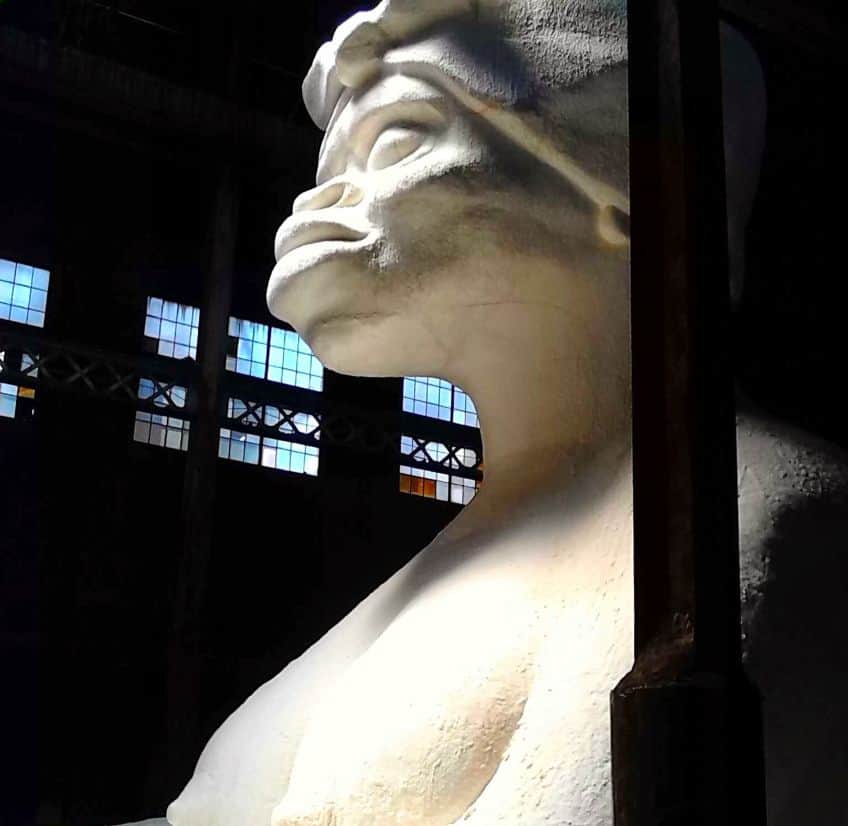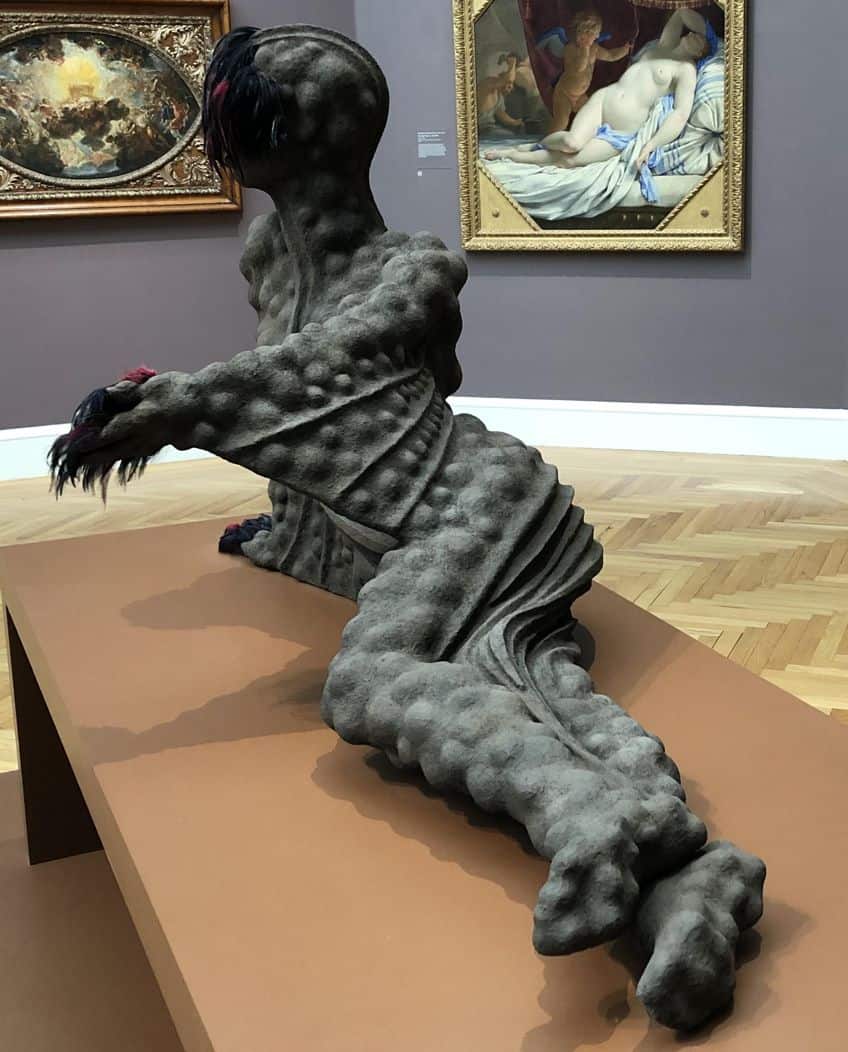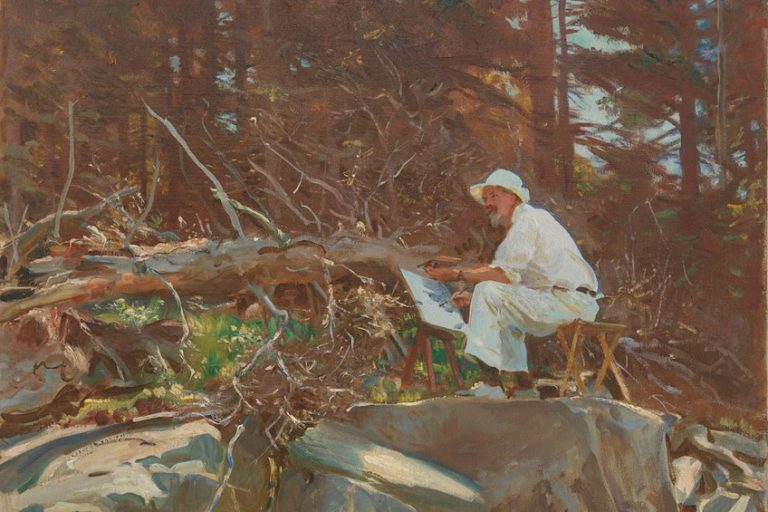Black Female Artists – The Voice of Black Women Artists
While the recent rise in such lists suggests a promising interest in this category of artists, it also points to the fact that black women artists have experienced undervaluation within the context of art history. Therefore, this article should not be experienced as a form of exclusion or categorization, but as something of an ode to iconic artists who happen to be black women. Even after Jean-Michel Basquiat declared: “I’m not a black artist, I’m an artist,” it is still common, particularly in art discourse, to see lists designed around categories of race and gender. Categories such as black woman art or black girl art suggest that all other categories are reserved for white male artists.
Encountering Erasure
Black women artists have always existed. However, like many pre-colonial artists, they were simply unnamed. Even after colonization and the advent of Western rule, black women artists continued to operate on mass, albeit remaining nameless. For instance, in the 18th century, the Ndebele people of South Africa began their style of wall paintings which were performed by women. The dynamic symbols express notions of self, personal prayers, emotions, and principles. As they were under the subjugation of the Dutch colonizers at the time, these women artists used secret codes to communicate with their people.
The Ndebele style of painting was passed down by mothers from generation to generation. So common was this art of black female painters that women were judged on their worth as a wife or mother, based on how well they painted their home. Because the history of black female artists is so vast and unfathomable, this article focuses on the period during which they began to be named and written about within the context and canon of Western art history. Indeed, when it comes to the inclusion of the diverse types of artists that exist in the world, we have come a long way. Some of the most successful artists in the world today are black women.
Ten Black Female Artists You Should Know
Of course, a list of ten black women artists is inherently limited and vague. Black women artists may share their race and gender but their practices are not homogenous. As this list demonstrates, the diversity of their contexts means that black woman artworks explore a wide variety of methods and materials. One of the more common characteristics in the range of artistic practices of black women, is that many of them have dedicated their lives to teaching.
This tendency echoes a historical accent of passing down black women’s artistic traditions from generation to generation. A tradition of community and care, which reverberates through time and space.
Laura Wheeler Waring (1887 – 1948)
| Birth and Death | 16 May 1887 – 3 February 1948 |
| Associated Art Movements | Modernism and the Harlem Renaissance |
| Nationality | American |
Laura Wheeler Waring was a painter and educator who taught art at Cheyney University in Pennsylvania for over 30 years. Having grown up in the late 19th century, Wheeler Waring yearned to see artists or portraits of people who resembled her. As such, Wheeler Waring’s work tackles notions of subjective portraiture in art history. Many black female painters living in this period may have struggled to afford traditional art materials such as oil canvases and paints. They would have had limited access to the Western art world. Fortunately, Wheeler Waring was born into a wealthy upper-class family, which gave her access to art materials, and opportunities.

Wheeler Waring had the privilege of studying art in Paris, spending much of her time at the Louvre where she became inspired by Matisse, Gaugin, Monet, Manet, Corot, and Cézanne who were master portrayers of the people and environments they knew best. Every stroke of paint in her famous oil paint-on-canvas painting The Study of a Student (c. 1940s) has been applied so that the brush marks remain visible, yet subtle. The skin tones are fresh and the blue of the flower in the subject’s hair provides a sharp contrast while the pink in the background brings a quiet calm into the atmosphere. Wheeler Waring is recognized for her portraits of accomplished and prominent African Americans which were commissioned by the Harmon Foundation in Philadelphia.
These iconic portraits were an important aspect of the Harlem Renaissance. In 1927 Laura Wheeler Waring was chosen to participate in America’s first public display of African American Art.
Alma W. Thomas (1891 – 1978)
| Birth and Death | 22 September 1891 – 24 February 1978 |
| Associated Art Movements | Modernism, Abstraction, Abstract Expressionism, and Color Field Painting |
| Nationality | American |
Alma Woodsey Thomas was an abstract painter and educator whose paintings have been exhibited in prominent museums and collections. Thomas is acknowledged as one of the key American painters of the 20th century. In 1924, Thomas earned a degree in Fine Art from Howard University – a historically black university. Woodsey Thomas was not only the first graduate of Howard University’s Fine Arts department, but one of the first African American women to earn a Fine Art degree. Thomas taught at Washington’s Shaw Junior High School for 38 years, retiring in 1960.

While Thomas’ foundational work is naturalistic, Howard University professors encouraged her to experiment, and eventually, she turned to abstraction. This shift happened largely after Thomas had retired from teaching, being able to concentrate on art full time, and finally developing a signature style. Thomas’ colorful abstract paintings experimented with line, shape, color, and pattern. The exuberant compositions earned her a title as one of the key members of the Washington Color School, a Washington, D.C based 1950s to 1970s art movement.
One of her most recognizable works is The Eclipse (1970). This painting is from her series of around fifteen works called “Space Paintings” inspired by everything from rocket launches to sunsets. Alma Thomas made the experiential, mosaic-like, warm-glow painting The Eclipse after witnessing the 1969 Moon landing.
Loïs Mailou Jones (1905 – 1998)
| Birth and Death | 3 November 1905– 9 June 1998 |
| Associated Art Movements | Harlem Renaissance, Textile Design, Haitian and African Art |
| Nationality | American |
Lois Mailou Jones was an artist and educator whose prolific career spanned seven decades. Today Loïs Mailou Jones artworks are housed in the collections of The Metropolitan Museum of Art and the Smithsonian American Art Museum to name a few. Having grown up in a middle-class family, Jones’ talent was discovered early. During one of her childhood summers, one of her beautician mother’s clients became an early supporter of Jones’ art. The client had a set of Japanese books, depicting hand-painted flowers. Jones was allowed to borrow these books and paint after them, which became an important influence in Jones’ art.

Jones traveled the world during her lifetime and maintained a special attachment to France. There, she developed her artistic style, deriving a painterly mode influenced by her European adventures. The seascape painting Boats at Théoule (1965) depicts the harbor at Theoule-sur-Mer in the French Riviera. Here, Jones used a thin tool called a palette knife to mix the complementary tones of paint and apply them in thick strokes onto the canvas. The palette knife was also used to create the sharp lines which operate as outlines on the boats. Jones’ strong sense of design produced paintings known for their lush and brilliant colors.
While her work was once declared as ‘proof of the talent of black artists’, Jones who lived to be 92 years old, had wished to be known as an ‘artist, without further labels’.
Gladys Mgudlandlu (1917 – 1979)
| Birth and Death | 1917 – 17 February 1979 |
| Associated Art Movements | Modernism, Impressionism, Expressionism, and Landscape Painting |
| Nationality | South African |
Gladys Nomfanekiso Mgudlandlu was a South African qualified educator who taught in Cape Town and an artist who only began to paint professionally at the age of 40. In 1962 Mgudlandlu became one of the first black women artists in apartheid era South Africa to present a solo exhibition. Whilst her first exhibition was criticized for its naivete, it was a commercial success with more than 2000 in attendance at the opening. Mgudlandlu lost her mother at a young age and was raised by her grandmother who trained her in traditional Xhosa wall painting. These traditional painting styles from their Fingo and Xhosa heritage would influence Mgudlandlu’s artistic style greatly.
In her painting Huts (1966) Mgudlandlu made hills appear to be surging like waves. The group of huts nestled together seem to tumble and float above these hills. The Huts appear as if they are sinking into the ground. As if the grass will grow above them. The mountains in the background are bare. There are no roads or streetlights, just huts, and hills. Though they were fewer, Mgudlandlu also painted portraits. Often her figures are depicted as shadows to represent spirituality or the ancestors. Men are often replaced with women in her traditional cattle herding scenes. The reason was that men were often absent in rural communities. Being migrant workers, living in the city, and working in the mines. By far though Mgudlandlu was best known for her portrayals of birds.
The artist once revealed in an interview that she was quite a lonely character, so she had developed an affiliation with birds. Mgudlandlu’s paintings feature birds common in the region of the Eastern Cape, many of them in full flight. Even her landscapes are painted from a bird’s eye view.
Faith Ringgold (1930 – Present)
| Birth and Death | 8 October 1930 – Present |
| Associated Art Movements | Textile Art, Performance Art, Political Art, Sculpture, African art, Impressionism, and Cubism |
| Nationality | American |
Faith Ringgold is a living artist, author, educator, and Civil Rights activist with a career that spans over 70 years. Ringgold made her mark during the American civil rights movement of the 1960s. In the 1960s, Ringgold struggled to gain recognition as a black female artist. She was overlooked or criticized as her early paintings focused on the underlying racism of the everyday. Ringgold’s work is an observation of decades of socio-political issues in America.
In 1968, The Whitney Museum in New York presented a retrospective of American art. The exhibition surveyed American art from the 1930s onward but excluded all black artists. Along with numerous notable black artists, Ringgold protested this racist assertion. Her painting Four Women at A Table (1962) portrays four self-righteous-looking white women with highly quaffed hair and monochromatic office wear, seated at a green table, and surrounded by a green-looking background. Four Women at A Table is from a period when she worked as a teacher but was not allowed a seat at the table in question. Ringgold was required to sit with the black people. Ringgold recalls that painting white people in a negative or critical light incited derision as the trouble-making black female artist.
Ringgold gained recognition for her narrative quilts which eventually became her signature style. The lush, colorful, daring patchwork of images contain stories inscribed onto the fabric. These quilts narrate the stories of people in the Black community.
Adrian Piper (1948 – Present)
| Birth and Death | 20 September 1948 – Present |
| Associated Art Movements | Conceptual art, Photography, and Performance art |
| Nationality | American |
Adrian Margaret Smith Piper is an award-winning conceptual artist and Kantian philosopher whose impact on “the language and form of Conceptual art” is widely recognized. Through various traditional and non-traditional media, Piper’s art interrogates professional ostracism, otherness, and racism. Piper’s Catalysis III (1970) is part of a series of public performances from the 1970s. In Catalysis III Piper shopped at a Macy’s while she wore a sign that read: “Wet Paint” and dripped white paint. The Catalysis series was a performance of gestures concealed from the viewer who is often unaware that they are taking part in the art. Piper’s simple gestures expose the complex racial and gender dynamics of public space.

In Catalysis III, Piper’s “Wet Paint” sign can be interpreted as a Do Not Touch sign aligning Feminist Art which critiques the male gaze. By confronting the viewer with their own gaze, Piper suggests that looking is a form of touching. With this performance, Piper denies homogenous categorization simply as an artist, woman, or person of color. While they assert autonomy, they challenge social dynamics and public perceptions, making Piper’s performances hazardous to her mental, professional, and physical wellbeing. Piper’s simple yet radical public gestures reveal a political existence that cannot be separated from her physical and intellectual being. In Piper’s own words, the artist is ‘a paradigm of what society is’.
Decades later, Piper’s performances have inspired a new generation of black women artists who reject the oppressive presuppositions of their white audiences.
Ellen Gallagher (1965 – Present)
| Birth and Death | 16 December 1965 – Present |
| Associated Art Movements | Afrofuturism and Contemporary Art (painting, drawings, printmaking, collage, and video) |
| Nationality | American |
For the past 25 years, Ellen Gallagher has been one of the world’s leading artists. Gallagher burst onto the contemporary American art scene in the early to mid 1990s capturing the attention of collectors and curators alike. Gallagher’s work has been part of various solo and group exhibitions, being held in the permanent collections of numerous major museums. She was recently featured in the Venice Biennale, one of the most reputable exhibitions in the world. Gallagher is best known for her large-scale grid-like compositions, drawn from advertising imagery which the artist manipulates and abstracts. Gallagher’s materials range from plasticine to glitter.
Her sources include American magazines such as Ebony and Sepia. She cuts, inserts, or pastes the found images into new configurations. Her manipulations can be so extreme that everything is redacted, leaving nothing but a void from which to conjure new meaning. Gallagher’s work Oh Susana! (1993) was her final painting at art school and it made her name in New York’s 90s art scene. The artwork gets its name from a popular 19th century minstrel song and is made in Gallagher’s signature top to bottom grid style. Gallagher’s subjects are portrayed in subversively disembodied ways to evoke a dark part of American history.
Often braille-like details in the eyes and thick lips mimic the make-up used by entertainers who played black characters in minstrel shows. Gallagher’s work confronts the viewer with the painful absurdity of the past.
Kara Walker (1969 – Present)
| Birth and Death | 26 November 1969 – Present |
| Associated Art Movements | Contemporary art (painting, silhouettes, printmaking, installation, and video) |
| Nationality | American |
Kara Elizabeth Walker is one of the most distinguished living African American artists. In 1997, Walker was awarded the MacArthur Fellowship. At the age of 28, this made her one of the award’s youngest recipients. Among many other accomplishments, she has been a professor at Rutgers University since 2015. Walker gained recognition for her large tableaux artworks of black cut-paper silhouettes that depict historical narratives. For her cut-outs, Walker uses the Victorian portraiture technique of silhouettes which she pastes directly onto the walls of galleries and museums.

Having discovered her process after having an excess of black paper in her studio, Walker draws her images on large pieces of black paper with a soft pastel crayon, then extracts the figures with her exacto knife. She then uses wax to paste the cutouts often directly onto the gallery wall. My Complement, Me Enemy, My Oppressor, My Love (2007-2008) depicts a Southern belle on the banks of a bayou leaning in to kiss her suitor under a Spanish moss tree and a full moon. A thin pair of legs poke out from under the maiden’s skirt. Nearby, a child chokes a duck, a woman defecates babies and another woman’s body is a boat. A prepubescent black girl in the center of the artwork appears to be giving a slave owner’s son fellatio while the master engages in a bizarre communion with another black woman.
Walker’s art investigates issues of race, gender, sexuality, and how they are influenced by power and violence. Her work provokes criticality, contemplation, controversy, confronting museum spaces with the terror of history, and challenging American revisionist history.
Wangechi Mutu (1972 – Present)
| Birth and Death | 22 June 1972 – Present |
| Associated Art Movements | Afrofuturism and Contemporary art (painting, collage, sculpture, installation, video, and performance) |
| Nationality | Kenyan-American |
Wangechi Mutu’s practice is based on collage, painting, sculpture, film and performance. Mutu’s mother was a nurse, so growing up the artist had access to numerous images of tropical diseases which became a large influence in her practice. In the hideous images of the most extreme examples of these diseases, Mutu learned to find beauty in ugliness. While most of Mutu’s source material is from glossy fashion magazines, it also includes fashion, lifestyle, pornography, and automobile magazines. Mutu’s source images portray women as idealized and homogenous, exposing a lack of representation of black women in mass media.

Mutu’s collages usually depict a black female central subject with surreal and animalistic features conjured through the cutting and remixing of various images. Mutu’s abstraction of the human body imbues the surreal into mundane forms. She compares her process to surgery. Some alchemic operation where she forces various realities together. In works such as Pretty Double-Headed (2010) Mutu’s recurring interest in tropical diseases is apparent. The figure which is constructed from cut-out elements appears to have morphed into something otherworldly. The subject which seems to have undergone a process of self-multiplication is both beautiful and grotesque.
While they are alluring, these images are not about desire but the twisted violence and erasure inflicted against black women. The result is a hybridity which is simultaneously alluring and repulsive, synthesizing the man-made world with the natural one.
Lynette Yiadom-Boakye (1977 – Present)
| Birth and Death | 1977 – Present |
| Associated Art Movements | Contemporary art (painting and Naturalism) |
| Nationality | British-Ghanaian |
Lynette Yiadom-Boakye is a painter and writer whose paintings are widely represented in solo exhibitions. Her 2013 Turner Prize nomination came as a result of her solo show Extracts and Verses at the Chisenhale Gallery in London. Yiadom-Boakye’s paintings use dark, muted colors and mysterious narratives. The artist’s process is instinctive and imaginative, which becomes the narrative. The artist’s painterly process is rapid, with most of her pieces taking only a day to complete. In Yiadom-Boakye’s words: ‘Coming back to a work never improves it’. Most of the paintings depict imaginary subjects, and found objects. The portraits feature generic clothing and settings that are difficult to discern. While the figures in Yiadom-Boakye’s paintings are fluid and fictional, they are sourced from the artist’s memories.
The Uncle of the Garden (2014) triptych depicts a black man who seems to be perpetually looking in one direction. Save for the title, the artist offers who the figure is. The vaporous and dark background serves to evoke a figure from the viewer’s own memories. The viewer is invited to conjure a story for this mysterious figure, whose facial expression is a combination of contemplation and anxiety. While there are people in her paintings, Yiadom-Boakye doesn’t declare her works as portraits. Some figures, poses, and themes recur as reminders of ideas the artist finds generative for the work. Yiadom-Boakye cites influences such as Manet and Degas.
Part of the triumph of black woman artwork is that it emerges from the complex conundrum of both an unfathomable past which precedes colonial notions of artistic practice, as well as the somewhat futuristic groundswell of artistic energy that seems to be propelling newly liberated peoples. Black woman artwork offers the viewer something they may have missed in the long, but homogenous art history canon. Its mission is to write itself into history, and therefore both inspire and enlighten its viewer.
Frequently Asked Questions
Who Is the Most Well-Known Black Female Artist?
There are constantly new it-girls capturing the art world’s attention, but Laura Wheeler Waring arguably remains the most famous and well-respected black female artist.
What Is the Most Expensive Black Woman Art or Black Girl Art?
It is hard to say as this is a field that has had such few dedicated scholars. However, in 2019, Amy Sherald’s work, The Bathers (2019), sold at auction at Phillips New York for the artist’s record price of $4,265,000. During a private transaction in 2021, Alma Thomas’s painting, Alma’s Flower Garden (1970), was reportedly sold for $2,800,000.
Who Painted Michelle Obama’s Official Portrait?
In 2018, the Baltimore-based artist Amy Sherald was awarded the opportunity to paint a portrait of the then First Lady of the United States, Michelle Obama. Sherald’s painting now hangs in the National Portrait Gallery in Washington D.C.
Isabella studied at the University of Cape Town in South Africa and graduated with a Bachelor of Arts majoring in English Literature & Language and Psychology. Throughout her undergraduate years, she took Art History as an additional subject and absolutely loved it. Building on from her art history knowledge that began in high school, art has always been a particular area of fascination for her. From learning about artworks previously unknown to her, or sharpening her existing understanding of specific works, the ability to continue learning within this interesting sphere excites her greatly.
Her focal points of interest in art history encompass profiling specific artists and art movements, as it is these areas where she is able to really dig deep into the rich narrative of the art world. Additionally, she particularly enjoys exploring the different artistic styles of the 20th century, as well as the important impact that female artists have had on the development of art history.
Learn more about Isabella Meyer and the Art in Context Team.
Cite this Article
Isabella, Meyer, “Black Female Artists – The Voice of Black Women Artists.” Art in Context. April 27, 2023. URL: https://artincontext.org/black-female-artists/
Meyer, I. (2023, 27 April). Black Female Artists – The Voice of Black Women Artists. Art in Context. https://artincontext.org/black-female-artists/
Meyer, Isabella. “Black Female Artists – The Voice of Black Women Artists.” Art in Context, April 27, 2023. https://artincontext.org/black-female-artists/.











